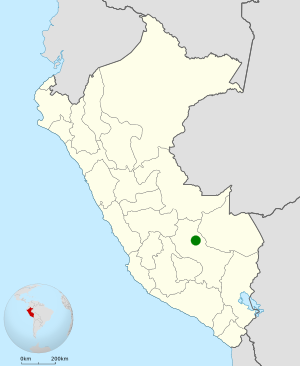Vilcabamba tapaculo facts for kids
Quick facts for kids Vilcabamba tapaculo |
|
|---|---|
 |
|
| Conservation status | |
| Scientific classification | |
| Genus: |
Scytalopus
|
| Species: |
urubambae
|
 |
|
The Vilcabamba tapaculo (Scytalopus urubambae) is a small passerine bird. It belongs to the Rhinocryptidae family. This bird lives only in Peru.
Contents
About the Vilcabamba Tapaculo
How Scientists Classify This Bird
The Vilcabamba tapaculo was first thought to be a type of Magellanic tapaculo. Scientists called it Scytalopus magellanicus urubambae. But in 1997, a new study showed something interesting. Scientists found that its songs and calls were very different. Because of these unique sounds, it was then named its own separate species.
What Does the Vilcabamba Tapaculo Look Like?
The Vilcabamba tapaculo is a small bird. It is about 10 to 12 cm (3.9 to 4.7 in) long. One male bird weighed about 13 g (0.46 oz). It looks a bit like a wren. It has a thin beak and fairly long legs. Its tail is short and often held straight up.
Colors of the Male Bird
Male Vilcabamba tapaculos are mostly gray. Their upper parts are dark gray. Their chest is a medium gray. This color fades to a pale gray on their belly. The area above their tail, called the rump, is reddish-brown. It has faint lines or bars. Their sides and the area under their tail are cinnamon colored. These parts also have faint bars.
Colors of the Female Bird
Female Vilcabamba tapaculos look similar to males. However, the gray on their upper parts is lighter. Their neck might have a brownish tint. Their sides are a brighter reddish-brown. Unlike the males, the females do not have bars on their sides.
Colors of Young Birds
Young Vilcabamba tapaculos have brown upper parts. Their back is darker than their rump. Their chest and belly are a greenish-yellow color. Their sides and the area under their tail are a yellowish-buff.
Where the Vilcabamba Tapaculo Lives
This special bird lives only in southern Peru. You can find it in the upper Urubamba Valley. This area is in Peru's Department of Cuzco.
Its Mountain Home
The Vilcabamba tapaculo lives high up in the mountains. It can be found at elevations from 3,500 to 4,200 m (11,500 to 13,800 ft). Its home is usually in damp mountain forests. These are often called "elfin forests." These areas often have a lot of moss and large rocks.
How the Vilcabamba Tapaculo Behaves
Scientists do not know much about what the Vilcabamba tapaculo eats. They also do not know how it finds its food. Its breeding habits are also a mystery. However, experts believe its behavior is similar to other tapaculos that live in high mountains.
The Bird's Unique Sounds
The Vilcabamba tapaculo has a special song. One expert, D.F. Lane, described it as "chree-chree-chree-chree." Others have called it "a raspy chit-chit" or "a churr." Its call is different from its song. The call sounds like "a rising and falling kikikikiki." You can listen to examples of its sounds online here.
What is the Vilcabamba Tapaculo's Status?
The IUCN (International Union for Conservation of Nature) checks on animals around the world. They have said the Vilcabamba tapaculo is of "Least Concern." This means it is not in danger right now. Even though it lives in a small area, its population seems to be steady. Human activities are not threatening it at this time.
See also
 In Spanish: Churrín de Vilcabamba para niños
In Spanish: Churrín de Vilcabamba para niños


